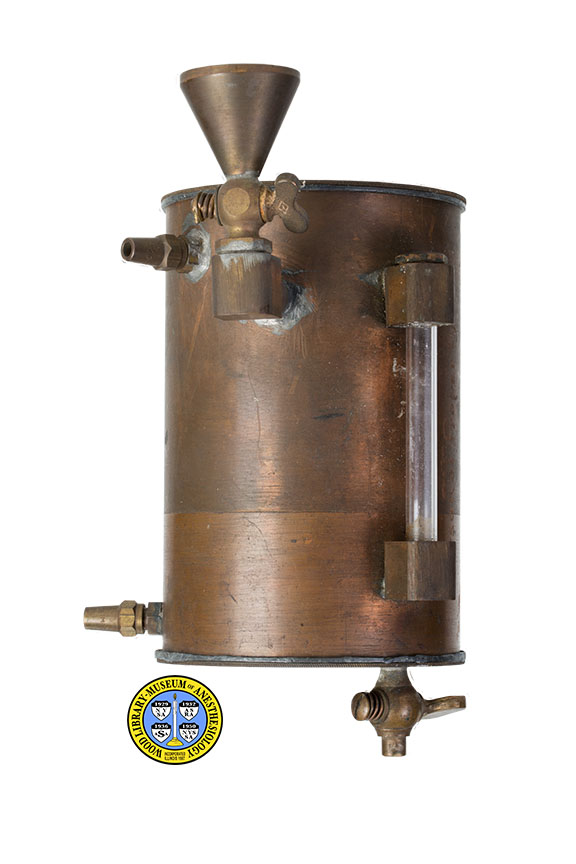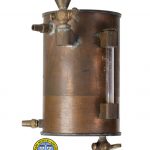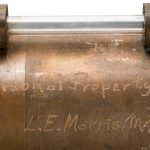Copper Kettle Prototype
Copper Kettle “Wisconsin Prototype”
As anesthetic liquids are vaporized, their temperature drops. Variations in temperature, in turn, can impact the performance of the vaporizer. Lucien E. Morris, M.D. (1914-2011) designed the Copper Kettle Vaporizer to perform with great accuracy, in part by maintaining a constant temperature. He began work on it in 1948, while a resident under Dr. Ralph Waters at the University of Wisconsin, Madison. The commercial model was manufactured by the Foregger Company, of New York from 1952 through the 1970s.
The design was a departure from that of its predecessors in three important ways. First, most vaporizers added an unknown concentration of vaporized liquid to a measured amount of gas; the Copper Kettle allowed the vapor to be added in known quantities that could be precisely measured and controlled through a separate circuit built into the anesthesia machine. Second, heat is required to convert volatile anesthetics from the liquid to gas form. Most vaporizers were made of glass which conducts heat poorly and so the temperature of the liquid in the vaporizer dropped rapidly in use; the Copper Kettle is made from materials that conduct heat well, keeping the liquid warm. Third, by dispersing the carrier gas through the liquid in a large number of very small bubbles, it further increased the speed and efficiency of vaporization.
The Copper Kettle could be calibrated to vaporize any volatile liquid anesthetic, such as chloroform, ether, halothane (Fluothane), or enflurane (Ethrane). Dr. Morris intended the vaporizer to be carefully adjusted by the anesthesiologist in response to the changing needs of the patient throughout the course of an anesthetic.
Catalog Record: Copper Kettle Prototype
Access Key: amed
Accession No.: 2010-09-23-7 J
Title: [Copper kettle Wisconsin prototype] / [designed by Lucien E. Morris.]
Author: Morris, Lucien E. (Ellis), 1914-2011.
Title variation: Alt Title
Title: [Prototype side-fill copper kettle vaporizer]
Publisher: [Madison, Wisconsin?] : [Name of manufacturer not identified], [Not earlier
than 1948 and not later than 1972].
Physical Descript: 1 vaporizer : copper, glass, metals ; 22 x 14 x 16 cm.
Subject: Anesthesia, Inhalation – instrumentation.
Subject: Vaporizers.
Subject: Chloroform – administration & dosage.
Subject: Morris, Lucien E. (Ellis), 1914-2011.
Note Type: General
Notes: Cataloger constructed descriptive title based on Foregger catalog no. 12,
1955, pp. 14-23, two articles coauthored by Feldman and Morris published in
1958, and the donor’s inventory. Date range based on published and
unpublished accounts by the inventor, and other publications (see historical
note).
Note Type: General
Notes: The Lucien Morris Collection consists of both personal papers and equipment.
The inventory provided by the donors in 2010 includes one vaporizer,
described as “Copper vaporizer made in shop @ Wisc., original effort for
sintered bronze”. The object cataloged in this record is the only vaporizer
received from the donors in 2010.
Note Type: Citation
Notes: Dorsch JA, Dorsch SE. Understanding Anesthesia Equipment: Construction, Ccare
and Complications. Baltimore, MD: Williams & Wilkins; 1975.
Note Type: Citation
Notes: Feldman SA, Morris LE. Vaporization of halothane and ether in the copper
kettle. Anesthesiology. September-October,1958;19(3):650-655.
Note Type: Citation
Notes: Foregger R. Death of a Company. 2nd ed. Milwaukee, WI: Richard Foregger; 2000
Note Type: Citation
Notes: The Foregger Company. Catalog No. 10. New York, NY: The Foregger Company;
1952.
Note Type: Citation
Notes: The Foregger Company. Catalog No. 12. New York, NY: The Foregger Company;
1955.
Note Type: Citation
Notes: The Foregger Company. Catalog No. 16. New York, NY: The Foregger Company;
1960.
Note Type: Citation
Notes: The Foregger Company. Anesthesia Apparatus, Catalog 17. New York, NY: The
Foregger Company; 1962.
Note Type: Citation
Notes: The Foregger Company. Copper kettle. Roslyn Heights, NY; The Foregger
Company; 1966.
Note Type: Citation
Notes: Inventory from the donor, Lucien E. Morris, M.D. Accession file 2010-09-23-7.
Located at: Wood Lilbrary-Museum of Anesthesiology, Schaumburg, Illinois.
Note Type: Citation
Notes: Morris LE. CHCl3 Analysis [a notebook in the Lucien E. Morris, M.D.
Manuscript Collection]. 1947-1948. Located at: Wood Library-Museum of
Anesthesiology, Schaumburg, Illinois.
Note Type: Citation
Notes: Morris LE. Copper kettle revisited. Anesthesiology. April,
2006;104(4):881-884. https://anesthesiology.pubs.asahq.org/article.
aspx?articleid=1923446&resultClick=3. Accessed July 31, 2015.
Note Type: Citation
Notes: Morris LE. A new vaporizer for liquid anesthetic agents. Anesthesiology.
November, 1952;13(6):587-593. https://anesthesiology.pubs.asahq.org/article.
aspx?articleid=1971308&resultClick=3. Accessed July 31, 2015.
Note Type: Citation
Notes: Morris LE, Bamforth B. Interview with Lucien Morris by Betty Bamforth [DVD].
Park Ridge, Illinois: Wood Library-Museum of Anesthesiology; 1981. John W.
Pender Collection of the Living History of Anesthesiology.
Note Type: Citation
Notes: Morris LE, Feldman SA. Considerations in the design and function of
anesthetic vaporizers. Anesthesiology. September-October,1958;19(3):642-649.
Note Type: Citation
Notes: Morris LE, Feldman SA. Evaluation of a new anaesthetic vaporizer. Anaesthesia
January, 1962;17(1):21-28.
Note Type: Citation
Notes: Morris LE, Morris DC. The development of the copper kettle with comments on
vaporizers that preceded and followed. In: Eger EI, Saidman LJ, Westhrope RN,
eds. The Wondrous Story of Anesthesia. New York, NY: Springer, 2014:715-721.
Note Type: Citation
Notes: Morris LE, Schroeder ME, Warner ME. Ralph Milton Waters, M.D.: mentor to a
profession: proceedings of the Ralph M. Waters symposiuim on professionalism
in anesthesiology, Madison, Wisconsin 2002. Park Ridge, IL: Wood
Library-Museum of Anesthesiology; 2004.
Note Type: Citation
Notes: Sands RP, Bacon DR. The copper kettle: a historical perspective. J Clin
Anesth. September, 1996;8:538-532.
Note Type: Citation
Notes: Schreiber P. Anaesthesia Equipment: Performance, Classification and Safety.
New York, NY: Springer-Verlag; 1972.
Note Type: Physical Description
Notes: One prototype of a vaporizer, made almost entirely of copper; It is
cylindrical in shape, with protruding parts;
The top of the cylinder is a flat, threaded plate, 10.5 cm in diameter, that
screws into the body of the cylinder; The upper surface of this plate has two
shallow holes, .5 cm in diameter, that do not penetrate the full thickness of
the plate; This plate can be unscrewed to open the barrel; A rubber gasket
ring is set between this plate and the barrel;
Immediately below the top plate, a port or nipple, 3 cm in length, extends
outward from the wall of the cylinder; The port penetrates the wall of the
cylinder, connecting to a metal tube about 4 cm in length that extends into
the cylinder; This tube connects to a metal disc that has an opening in its
center on the side facing the bottom of the cylinder;
Approximately 3 cm to right of this port, an elbow connection extends 4.5 cm
outward from the wall of the cylinder; The elbow joins a funnel, called “a
side arm funnel for filling the container” (Morris 2006); The funnel rises 5
cm above the elbow; The opening of the funnel is 3.5 cm in diameter at its
widest point, which stands 3 cm higher than the top plate; A stopcock is
mounted in the base of the funnel; The funnel functions to admit liquid to
the container; The cataloger did not test the functionality of the stopcock,
which is stiff and difficult to turn;
Approximately 4 cm to the right of the funnel, a clear glass tube is mounted
in two copper blocks (one at each end of the tube); These mounting blocks are
secured inside the wall of the cylinder, each with a circular opening that
accesses the tube; When the container is filled with liquid, a portion of the
liquid enters the tube through these openings, so that the tube functions as
a gauge to the level of the liquid in the barrel;
The bottom of the barrel consists of a permeable Porex disc (made of sintered
bronze); This disc is mounted 1.5 cm above the bottom of the cylinder;
The bottom of the cylinder is another flat, threaded plate, 10.5 cm in
diameter, that screws into the body of the cylinder; The upper surface of
this plate, also, has two shallow holes that do not penetrate the full
thickness of the plate, and a rubber gasket ring;
Between the Porex disc and the bottom of the cylinder there is a shallow
space with an inlet port in the wall of the cylinder for the admission of the
carrier gas under pressure; The inlet port is mounted 1 cm from the bottom
of the cylinder, and extends 3 cm outward from the body of the cylinder;
A stopcock, 3 cm in length, is mounted on the bottom plate; This stopcock is
placed 1.5 cm to the right of the lower mounting block of the glass tube; The
stopcock does not function, as it does not penetrate the bottom plate;
Removal of this plate reveals a shallow space below the Porex disc;
Parallel to the mounting blocks of the glass tube, the wall of the cylinder
is etched: “Personal Property of [new line] L. E. Morris, M.D.”
Note Type: Reproduction
Notes: Photographed by Mr. Steven Donisch, January 12, 2015
Note Type: Historical
Notes: As anesthetic liquids are vaporized, their temperature drops. Variations in temperature, in turn, can impact the performance of the vaporizer. Lucien E. Morris, M.D. (1914-2011) designed the Copper Kettle Vaporizer to perform with great accuracy, in part by maintaining a constant room temperature. He began work on it in 1948, while a resident under Dr. Ralph Waters at the University of Wisconsin, Madison. The commercial model was manufactured by the Foregger Company, of New York from 1952 through the 1970s.
The design was a departure from that of its predecessors in three important ways. First, most vaporizers added an unknown concentration of vaporized liquid to a measured amount of gas; the Copper Kettle allowed the vapor to be added in known quantities that could be precisely measured and controlled through a separate circuit built into the anesthesia machine. Second, heat is required to convert volatile anesthetics from the liquid to gas form. Most vaporizers were made of glass which conducts heat poorly and so the temperature of the liquid in the vaporizer dropped rapidly in use; the Copper Kettle is made from materials that conduct heat well, keeping the liquid warm. Third, by dispersing the carrier gas through the liquid in a large number of very small bubbles, it further increased the speed and efficiency of vaporization.
The Copper Kettle could be calibrated to vaporize any volatile liquid anesthetic, such as chloroform, ether, halothane (Fluothane), or enflurane (Ethrane). Dr. Morris intended the vaporizer to be carefully adjusted by the anesthesiologist in response to the changing needs of the patient throughout the course of an anesthetic.
Note Type: Acquisition
Notes: This prototype is part of the Lucien E. Morris, M.D. Manuscript Collection,
donated to the Wood Library-Museum of Anesthesiology in 2010 by Dr. Morris
and his family.
Note Type: Exhibition
Notes: Selected for the WLM website (noted August 28, 2015.)




